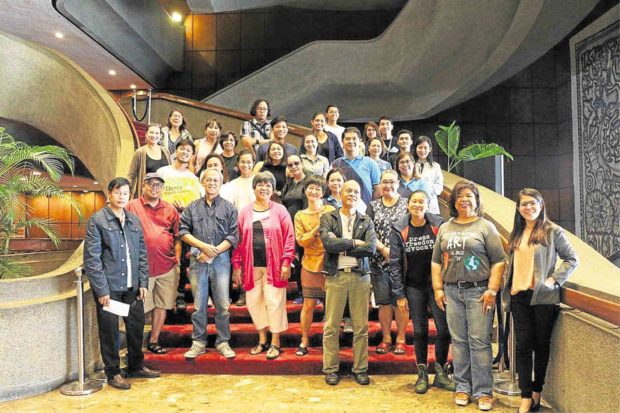
Founders and organizers of the Artists Welfare Project Inc. pose for a group picture. They seek to give freelance artists and media workers health insurance protection. —CONTRIBUTED PHOTO
LOS BAÑOS, Laguna — In December 2011, musician Lirio Salvador was crossing the street to get to an arts venue in Cavite province when a speeding motorcycle hit him. He is still undergoing brain therapy seven years after the accident.
“There were no visible injuries, [but] the damage was in the brain. He was at the ICU (intensive care unit) for 25 days and in the [hospital] room for three months,” recalled Salvador’s wife, Mary Ann, in a documentary produced by the Artists Welfare Project Inc. (Awpi).
The driver of the motorcycle had escaped, leaving the victim’s family and artist-friends to raise P1 million to cover hospital expenses. National Artist BenCab or Benedicto Cabrera donated an artwork.
Pushing the envelope
The case of Salvador, 50, who is known for his metal sculptures that function as musical instruments, was among the many Filipino artists “pushing the envelope most of their lives,” said Awpi executive director, Jennifer Lee Bonto. In most cases, artists resort to passing the hat when someone falls ill.
Bonto recalled Nonoy Froilan, considered the country’s premier male ballet dancer, coming home one night to a dark house without electricity because he was not able to pay the bill.
In 2011, the country’s biggest ballet companies staged a fund raising performance for Froilan’s wife and Ballet Philippines choreographer, Edna Vida, who was diagnosed with cancer. Several benefit gigs were also mounted for rock icon, Jun Lopito, when he fell ill and needed financial help.
“I don’t have an insurance. I don’t have anything. All I’ve got are friends, band mates, club owners. Otherwise, nothing,” Lopito said in the documentary.
Proactive
“We worked so hard. We gave our life to dance. But there was never any big financial compensation, which is still true until now. I don’t know if I’m expecting too much. I don’t know if we even deserve it,” Edna Vida said.
In the last decade, Awpi has been working with freelance artists on issues concerning health, housing and even education.
“We can’t just raise funds every time an artist gets sick. You raise P1 million, but how far does that really go?” Bonto said.
In 2017, Awpi gathered the first 150 artists to sign up as a group for a health care plan under a private insurance company. This year, it will again enjoin artists to fill up another 170 slots for the second batch.
Under the plan, each artist (ages 18 to 64) will pay only P10,000 to avail of P75,000 maximum coverage per illness for a year. The premium was usually higher when individually applied for, Bonto explained.
Strength in numbers
Even that amount, however, was not easy to raise for most artists with no steady income. Some borrow money while others pitch in to raise one member’s premium.
“We want to be proactive. The idea is to [promote] wellness even before someone gets bedridden or goes terminally ill,” Bonto said.
“Awpi cannot pay the hospital bills of all the artists. But this gathering of artists for HMO (health maintenance organization) has been an incredible milestone for our industry because it has been the most cost-efficient. Literally, strength in numbers,” the group said.
To Bonto, artists include people behind production—those preparing costumes, the stage and stunt men. Among those who have also signed up were freelance writers, photographers and media workers.
“Let’s not get confined to the standards that ‘artists’ must first have had a one-month exhibit. You dance, sing, write, as long as you feel that what you’re doing is an art [you qualify],” she said.
Health care was just one of the many challenges, she added.
In 2015, Rep. Niel Tupas Jr. introduced a bill that seeks to accredit artists so they could also enjoy medical and other benefits that professionals do.
All the more that artists need to stay healthy in order to continue lobbying for state support to the creative industry, Bonto said.